The Vought VE-7 "Bluebird" was an early biplane of the United States. First flying in 1917, it was designed as a two-seat trainer for the United States Army, then adopted by the United States Navy as its first fighter aircraft. In 1922, a VE-7 became the first airplane to take off from an American aircraft carrier. With only 128 made, it was completely eclipsed by the ubiquitous Curtiss Jenny, but gave valuable lessons in terms of carrier fighters until retired in 1928.

original 1916 logo, note the "aéroplanes" in French ("airplanes").
Vought a name found in several companies, but the original was Lewis and Vought Corporation, established by Chance M. Vought and Birdseye Lewis in 1917. The former was no less than the former chief engineer of the Wright Company for Wright brothers fame. As WWI ramped up, instead of fighting over patents (one reason why Chance left in the first place) he wanted his company to focus on military and civilian aviation. He created his office and workshop in Astoria, New York but in 1919 he moved his company to Long Island City.
After Lewis retired in 1922, the company became the Chance Vought Corporation. The first company was essentially about to create a licenced-built SPAD XIII. But in 1917 a US Army signal corps called for a multirole "cooperation" model. From there was designed in 1917 the Vought VE-7 trainer, a first commercial success and start of the long collaboration with the Navy. Indeed one of these bluebirds made the first takeoff from USS Langley's deck. Next was the VE-11, after the semi-failure of the VE-10 and complete failure of the VE-8. This was nevertheless the start of arguably the longest and most successful naval multirole lineage with the Vought O2U Corsair.
In 1928, the company was purchased by United Aircraft and Transport Corporation while kept as a separate division alongside giants such as Pratt & Whitney and Boeing. Vought died from sepsis in 1930, giving birth to a long line of USN/USAF models in many types. The Corsair was its best seller, widely export, used by all services for decades.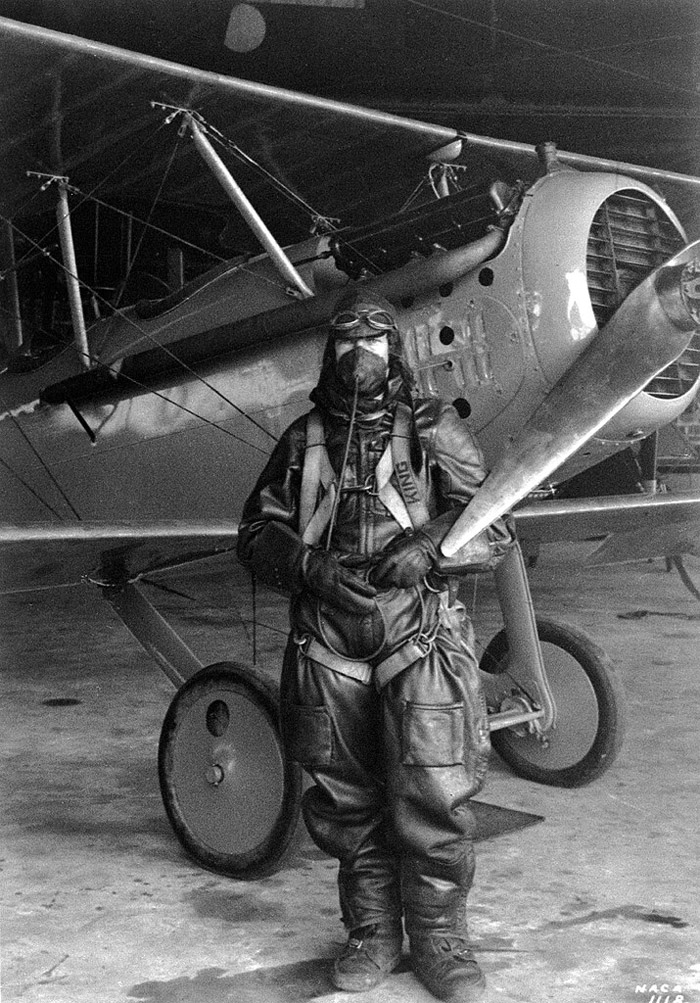
Pilot Paul King and his VE-7
Lewis & Vought Corporation created proposed a two-seat trainer (which did not existed in the French inventory) that could train pilots for the SPAD XIII in France, as deployed. One effort was made b Wright to acquire the licence of the inline Hispano engine for production in the US, not only to answer the demands for engines in Europe and equip American Spads, but also French ones, and the new trainer worked on.
The prototype was initially made in sections (like the fuselage and wings) completed in Vought's loft initially, lowered by rope and pulley through a removable window and... assembled in the street below. After the Spad Hispano Suiza 150-hp engine was installed, it was run up with the airplane’s tail tied to a telephone pole, trucked 25 miles to Hazelhurst Field. There, it competed against other designs in the Army Signal Corps for a contract. This advanced trainer was already supposed to replace the dependable Curtiss Jenny but other models suc as the Standard and Thomas-Morse. It had “Aeroplanes Vought” painted on its tail. But its true opponent was thought to be the Wright-Martin V.
The Wright Hispano Suiza gave the VE-7, along with its looks, remarkable performances. The VE-7 was designed as a two-seaters with the trainee in the forward cockpit, but the model's performance overall were on par with the original SPAD XIII and good enough to act as a fighter if needs be. In fact, he Bureau of Aircraft briefly considered building the VE-7 as a fighter. In March 1918, the official report stated:
The Aircraft Division at McCook Field was the first contracted, and delivered two aircraft. The other policy was to place large production contracts with low bidders companies, and by late October 1918, Gen. William L. Kenly (Army Dept. of Military Aeronautics) placed 1,000 VE-7s, notably to the Springfield Aircraft Corporation in Massachusetts. Soon Lewis & Vought Corp. was contracted for 500 more, but having still no capacity, it wa splaced to Sturtevant Aeroplane Company in Jamaica Plains also in Massachusetts and Gen. Kenly asked soon to have 3,000. The was still not over to that point. But the contract was cancelled in November. Vought worked on the VE-8 meanwhile, but it was rather a failure (see variants).
The was was over two weeks after the orders were places and ,o facility was able to deliver any models but McCook Field and Springfield Aircraft Corp., Sturtevant not delivering any. The fourteen initially purchased in May from Lewis & Vought had 5-6 delivered, circa 4 Springfield, 2 McCook Field. Earlier production was postponed due to all available Hispano engines diverted to the Curtiss Jenny. Vought escape bankrupcy, as the the Army contract remained in force, and continued deliveries with a $100,000 check cashed in on July 19, 1918.
In 1919, these crated VE-7’s arrived at McCook Field and Chance Vought, an authentic geek, convinced Master Sergeant Jack Harding supervising the completion work let hom supervised his own procedure, personally praising the bird.
The Navy was still interested by the VE-7 after it was dropped by USAF for its own growing needs, and placed orders, with the first VE-7 trainers and VE-7S fighters arriving by May 1920 and production orders followed. The model was also purchased for a production run in Naval Aircraft Factory. Indeed, Vought lacked the capacity to produced the 1000 USAF models required, and also even the 120+ of the Navy.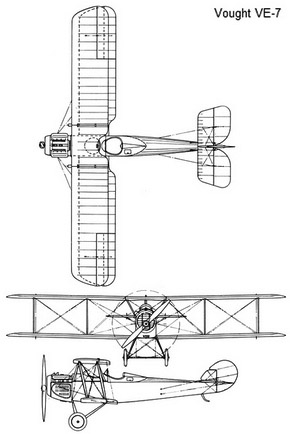

The VE-7s equipped the Navy's first two fighter squadrons; VF-1 and VF-2. A VE-7 flown by Lieutenant Virgil C. Griffin made US history on October 17, 1922: He flew off indeed for the first time, from the deck of the freshly commissioned US Aircraft carrier Langley. The VE-7 soon helped posing the base of the very first navy fighter unit, a solid foundation on which hundreds of fighter squadrons were built in the future. These pilots, officers and mechanics wrote the book. Thes Navy fighters remained frontline for many years, three still permanently assigned to USS Langley as late as 1927, but they were retired in 1928.
The VE-7 as a multirole model which was not supposed to compete but replace the Curtiss Jenny. Unfortunately, the end of the war put an end to a massive potential. The Jenny, upgraded with a new 150 hp engine, was soon in massive surplus and delivered instead to the civilian market, chief application being agricultural work, liaison (many tiny air transport company mushromed across the states) and of course, acrobatics. The far more confidential VE-7 never had this chance, but it left the Navy an immense respect for Vought.
About Vought VE-7
About Lewis & Vought Corp.

original 1916 logo, note the "aéroplanes" in French ("airplanes").
Vought a name found in several companies, but the original was Lewis and Vought Corporation, established by Chance M. Vought and Birdseye Lewis in 1917. The former was no less than the former chief engineer of the Wright Company for Wright brothers fame. As WWI ramped up, instead of fighting over patents (one reason why Chance left in the first place) he wanted his company to focus on military and civilian aviation. He created his office and workshop in Astoria, New York but in 1919 he moved his company to Long Island City.
After Lewis retired in 1922, the company became the Chance Vought Corporation. The first company was essentially about to create a licenced-built SPAD XIII. But in 1917 a US Army signal corps called for a multirole "cooperation" model. From there was designed in 1917 the Vought VE-7 trainer, a first commercial success and start of the long collaboration with the Navy. Indeed one of these bluebirds made the first takeoff from USS Langley's deck. Next was the VE-11, after the semi-failure of the VE-10 and complete failure of the VE-8. This was nevertheless the start of arguably the longest and most successful naval multirole lineage with the Vought O2U Corsair.
In 1928, the company was purchased by United Aircraft and Transport Corporation while kept as a separate division alongside giants such as Pratt & Whitney and Boeing. Vought died from sepsis in 1930, giving birth to a long line of USN/USAF models in many types. The Corsair was its best seller, widely export, used by all services for decades.
Development

Pilot Paul King and his VE-7
Lewis & Vought Corporation created proposed a two-seat trainer (which did not existed in the French inventory) that could train pilots for the SPAD XIII in France, as deployed. One effort was made b Wright to acquire the licence of the inline Hispano engine for production in the US, not only to answer the demands for engines in Europe and equip American Spads, but also French ones, and the new trainer worked on.
The prototype was initially made in sections (like the fuselage and wings) completed in Vought's loft initially, lowered by rope and pulley through a removable window and... assembled in the street below. After the Spad Hispano Suiza 150-hp engine was installed, it was run up with the airplane’s tail tied to a telephone pole, trucked 25 miles to Hazelhurst Field. There, it competed against other designs in the Army Signal Corps for a contract. This advanced trainer was already supposed to replace the dependable Curtiss Jenny but other models suc as the Standard and Thomas-Morse. It had “Aeroplanes Vought” painted on its tail. But its true opponent was thought to be the Wright-Martin V.
The Wright Hispano Suiza gave the VE-7, along with its looks, remarkable performances. The VE-7 was designed as a two-seaters with the trainee in the forward cockpit, but the model's performance overall were on par with the original SPAD XIII and good enough to act as a fighter if needs be. In fact, he Bureau of Aircraft briefly considered building the VE-7 as a fighter. In March 1918, the official report stated:
If the VE-7’s were to be used for all training (primary and advanced), a saving of time would result as the student would be capable of at once handling a service-type machine without having to be put through the stepping-up process, as is at present the case.By May 1918, the Signal Corps, impressed by its performances, ordered a preserie of fourteen VE-7s from Vought. The government also purchased plans and rights to build it somewhere else, as Vought had at the time only his loft to do any work. It was high praised by Lt. Col. Virginius E. Clark, and it was not all.
This Vought machine, a training type, has all of the air qualities of the single-seater and will out-maneuver the French Spad, Nieuport, and the English SE-5.English, French, and Italian Aviation Missions's officials were equally impressed. It's finish rivaled the finest automobile with a blue trim which earned its nickname of “Bluebird”. It never was official. Lt. Alexander Klemin that made the aproval tests wrote:
Brig. Gen. Billy Mitchell.
No changes from the basic design are recommended, and the wing truss is perfectly satisfactory from a structural point of view. For flying qualities, this is the finest handling ship I ever flew.
The Aircraft Division at McCook Field was the first contracted, and delivered two aircraft. The other policy was to place large production contracts with low bidders companies, and by late October 1918, Gen. William L. Kenly (Army Dept. of Military Aeronautics) placed 1,000 VE-7s, notably to the Springfield Aircraft Corporation in Massachusetts. Soon Lewis & Vought Corp. was contracted for 500 more, but having still no capacity, it wa splaced to Sturtevant Aeroplane Company in Jamaica Plains also in Massachusetts and Gen. Kenly asked soon to have 3,000. The was still not over to that point. But the contract was cancelled in November. Vought worked on the VE-8 meanwhile, but it was rather a failure (see variants).
The was was over two weeks after the orders were places and ,o facility was able to deliver any models but McCook Field and Springfield Aircraft Corp., Sturtevant not delivering any. The fourteen initially purchased in May from Lewis & Vought had 5-6 delivered, circa 4 Springfield, 2 McCook Field. Earlier production was postponed due to all available Hispano engines diverted to the Curtiss Jenny. Vought escape bankrupcy, as the the Army contract remained in force, and continued deliveries with a $100,000 check cashed in on July 19, 1918.
In 1919, these crated VE-7’s arrived at McCook Field and Chance Vought, an authentic geek, convinced Master Sergeant Jack Harding supervising the completion work let hom supervised his own procedure, personally praising the bird.
The Navy was still interested by the VE-7 after it was dropped by USAF for its own growing needs, and placed orders, with the first VE-7 trainers and VE-7S fighters arriving by May 1920 and production orders followed. The model was also purchased for a production run in Naval Aircraft Factory. Indeed, Vought lacked the capacity to produced the 1000 USAF models required, and also even the 120+ of the Navy.
The creation of NAF (Naval Aicraft Factory)
The Navy anticipated this botleneck and created its own "state factory", called Naval Aicraft Factory to just produced models already developed outside. This had the advantage of procuring the models needed without waiting for the original factory's ramping up to meet the demand, and helping to secure a steady procurement, but also to have elements of comparison with private-owned companie's own tariffication and adjustments to market, helping to determine costs for future procurement programs.Production of the "Blue Bird"
Thanks to this, the 128 VE-7s were delivered, soon named the "Bluebird" given its first customer. One modified VE7S won the 1918 Army competition for advanced training machines as well. The Vought VE-7s served in many variants, some as floatplanes (see later). It was Vought's first success and a solid background to develop more advanced models such as the "OU" (for observation, Vought) family later (O1U, O2U, O3U, etc).Design of the Vought VE-7

General Layout
The bluebird was not a simple copy-paste of the SPAD XIII, the latter had some influence, notably around a similar engine, but it was larger and improved in many directions. Its Wingspan reached 34.29 ft for an overall Length of 24.17 ft, 8.58 ft in height and a Gross Weight of 1937 lb with a useful Load of 545 lb and an engine oil Capacity of 2.8 gallons. It was a single-bay model with cabane (straight struts, two pairs on each wing), equal span wings with very slight dihedral, rounded tail with some variants. The engine was followed by the main gravity+pump feed fuel tank, then the observer/apprentice seat behing the upper wing, and the pilot fiurther aft which could stand and clear the upper wing if needed due to its recess. Construction, apart the forward part partly in metal (radiator, engine nacelle) was in wood and canvas.Engine and Performances
It was given a Wright E-2 rated like the original Wright-Hispano 150 hp, but it was pushed to 180 hp in 1919. It was propelled by a standard two-bladed fix pitch wooden model. Thanks to it, the fuselage was much refined and aerodynamic compared to any radial engine, with a top Speed at Sea Level of 106 mph and a landing Speed at Sea Leavel of 48 mph. Initial Rate-of-Climb was 1176 ft/min and service Ceiling of 18,500 ft with an absolute Ceiling of 20,000 ft. The fighter VE-7S/SF was a bit heavier with its Vickers and later Browning LMG, but this added weight was compensated by the lack of obsverver. The space was occupied in part by the pump activating the floatation systems. The VE-7SF was ,not only the first Navy fighter, but also the first to test an arresting hook.Variants
VE-7 (1918)
14 built for the U.S. Army Air Service and 39 for the U.S. Navy (2 McCook Field, 4 Springfield Co)VE-7F (1921)
29 built for the U.S. NavyVE-7G (1921)
Floatplane, one converted from VE-7 for USMC, 23 for the U.S. NavyVE-7GF (1921)
One converted, no more infoVE-7H (1924)
9 observation seaplanes for the U.S. NavyVE-7S (1925)
Land based fighter version, single-seater, with front cockpit faired over and a .30 in (7.62 mm) Vickers machine gun mounted over it, left side and synchronized with the propeller. One converted.VE-7sF (1925)
Production, refined naval fighter variant, with flotation gear made of inflatable bags stowed away. They will help the plane staying afloat when ditching at sea long enough for the recue to come up and pickup the pilot. They also had a front undercarriage skid to prevent toppling over when landing. 11 built for the U.S. Navy.VE-7SH (1925)
Single VE-7SF fighter/observation for trials, not adopted.VE-8 (1918)
The VE-8 was completed in July 1919 with a 340hp Wright-Hispano H engine. It had reduced overall dimensions but greater wing area and a shorter faired cabane (wings-struts combo) as well as two Vickers machine guns; to make it a better fighter, with two completed and tested. Results were disappointing. Despite the added wing area it was still overweight due to the massive engine, and heavy controls. Pilots complained also of poor stability and lackluster performances in general for a fighter in all areas.VE-9 (1921)
Two converted from VE-7 for U.S. Army; speed increased to 119 mph (192 km/h), service ceiling increased to 18,840 ft (5,740 m). The VE-9 arrived to be tested by the Navy on 24 June 1922, as an improved VE-7, ditching away entirely the VE-8 and coming back to basics. The range was improved with a bigger tank and improves fuel system. Tests were positive. Four were ordered as unarmed observation floatplanes, specialized as battleship catapulted spotter planes. They were in service until replaced by the Vought Corsair (O series).VE-9 (1927)
22 built for the U.S. Army, 17 for the U.S. Navy.VE-9H (1927)
4 unarmed observation float seaplanes built for the U.S. Navy battleships, modified vertical tail surfaces for improved catapult and water stability.VE-9W
canceled.Detailed specs
Specs VE-7 | |
| Crew: | 2: Pilot, Observer/Gunner |
| Fuselage Lenght | 24 ft 5.375 in (7.45 m) |
| Wingspan | 34 ft 4 in (10.47 m) |
| Height | 8 ft 7.5 in (2.63 m) |
| Wing Area: | 284.5 sq ft (26.43 m2), airfoil RAF-15 |
| Empty weight: | 1,392 lb (631 kg) |
| Gross weight: | 1,937 lb (879 kg) |
| Powerplant: | Wright-Hispano E-3 liquid cooled V-8, 180 hp (134 kW) |
| Propeller: | 2-bladed, 8 ft 8 in (2.64 m) diameter, wooden fixed pitch |
| Maximum speed: | 106 mph (171 km/h, 92 kn) |
| Climb rate: | 738 ft/min (3.75 m/s) |
| Range: | 290 mi (467 km, 250 nmi) |
| Service ceiling: | 15,000 ft (4,600 m) |
| Armament - Guns | One .30 in sync. (7.62 mm) Vickers on the VE-7S |
| Armament - Bombs | None |
Combat Service

The VE-7s equipped the Navy's first two fighter squadrons; VF-1 and VF-2. A VE-7 flown by Lieutenant Virgil C. Griffin made US history on October 17, 1922: He flew off indeed for the first time, from the deck of the freshly commissioned US Aircraft carrier Langley. The VE-7 soon helped posing the base of the very first navy fighter unit, a solid foundation on which hundreds of fighter squadrons were built in the future. These pilots, officers and mechanics wrote the book. Thes Navy fighters remained frontline for many years, three still permanently assigned to USS Langley as late as 1927, but they were retired in 1928.
The VE-7 as a multirole model which was not supposed to compete but replace the Curtiss Jenny. Unfortunately, the end of the war put an end to a massive potential. The Jenny, upgraded with a new 150 hp engine, was soon in massive surplus and delivered instead to the civilian market, chief application being agricultural work, liaison (many tiny air transport company mushromed across the states) and of course, acrobatics. The far more confidential VE-7 never had this chance, but it left the Navy an immense respect for Vought.
Gallery
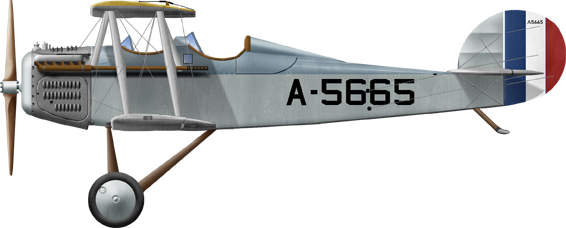
VE7 pilot Tony Fear, USS Langley 1923
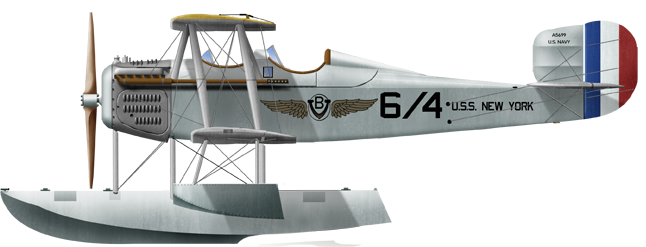
VE7G VO-6 USS New York, July 1922
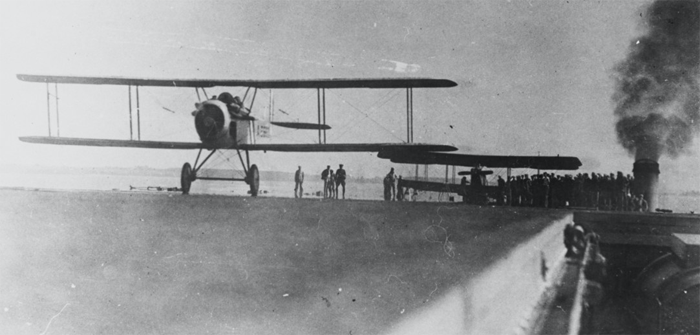
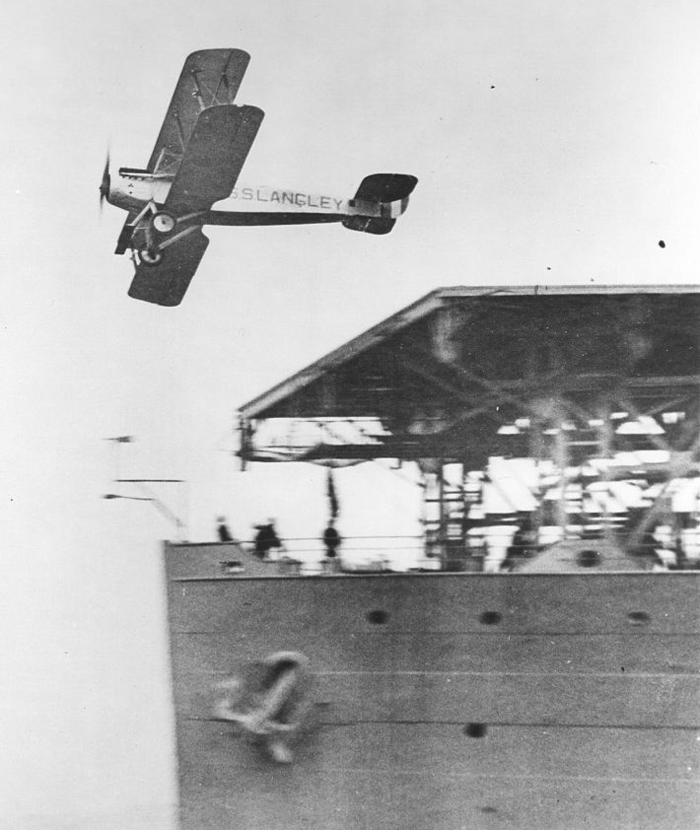
VE-7SF taking off USS Langley in 1922
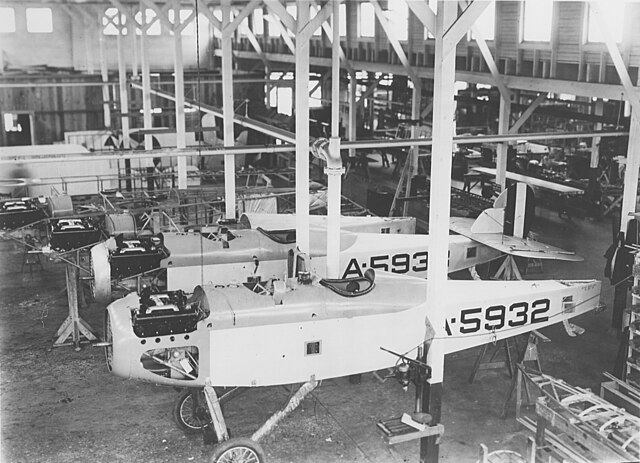
VE-7 assembly line, location unkown, probably Vought.
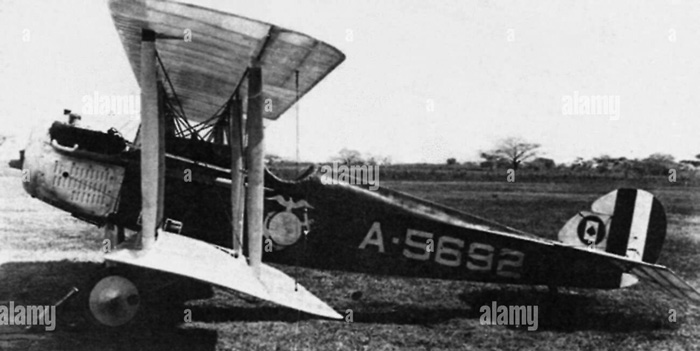
VE-7 of VO-1M USMC marked HF1JX8 at Santo Domingo in 1922
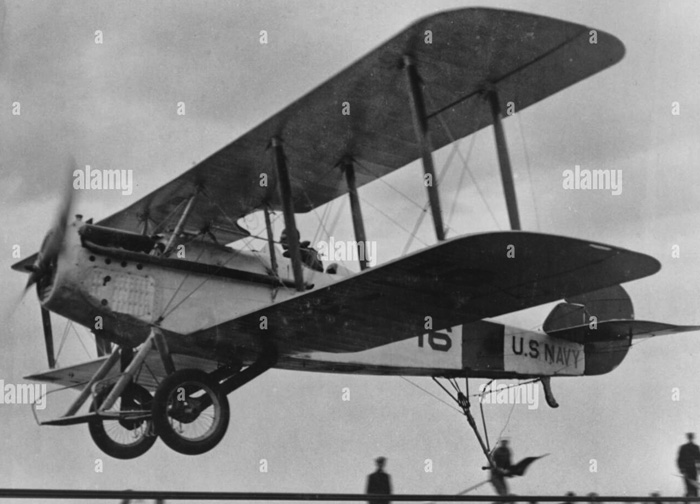
VE-7SF 6-f-16 landing on Langley. Note the tail and fuselage band squadron colored.
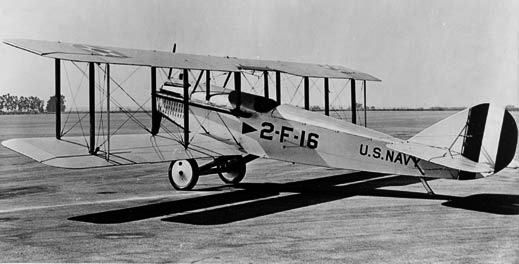
VE-7SF 2-F-16 note the longer production tail

VE-7G launched from USS Maryland, 1920s
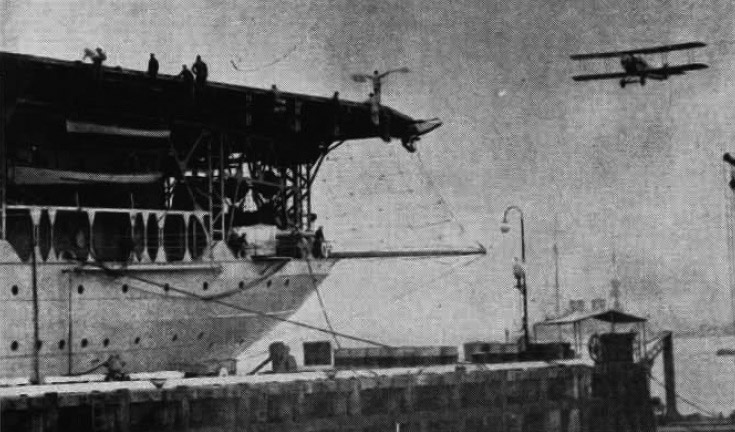
VE-7 approaching USS Langley in 1922. Note the landing marshall signaller. Hand signs used up to this day were pioneered there and then.
Read More and Sources
books
Lloyd S. Jones, U.S. Naval Fighters. Fallbrook CA: Aero Publishers, 1977Janes Fighting Aircraft of World War I by Michael John Haddrick Taylor. Random House Group Ltd.
The Complete Book of Fighters cover. William Green & Gordon Swanborough
Vought Aircraft Heritage Foundation, "VE-7 Bluebird". History.navy.mil.
Lednicer, David. "The Incomplete Guide to Airfoil Usage".
Millot, Bernard (October 1971). "Lewis-Vought VE.8 ou le malchanceux "Spad" americain" Le Fanatique de l'Aviation
links
vought.orgvought.org
vought.org
vought.org
history.navy.mil
web.archive.org/vought.com/
aviastar.org
flyingmachines.ru/
aeropedia.com.au
airwar.ru
USS landley on navsource.org
tlube.fortunecity.ws/corsairhistory_1
airandspace.si.edu
thisdayinaviation.com
wings-aviation.ch
colettiscombataircraft.com
militaryfactory.com
usaww1.com
1000aircraftphotos.com
history.navy.mil
extra photos on alamy
Model Kits

Olimp model review
Drawings, by Willis L. Nye.
Video
- Lohner E (1913)
- Macchi M3 (1916)
- Macchi M5 (1918)
- Ansaldo ISVA (1918)
- Sopwith Baby (1916)
- Short 184 (1916)
- Fairey Campania (1917)
- Sopwith Cuckoo (1917)
- Felixstowe F.2 (1917)
- Friedrichshafen FF 33 (1916)
- Albatros W4 (1916)
- Albatros W8 (1918)
- Hanriot HD.2
- Grigorovitch M5
- IJN Farman MF.7
- IJN Yokosho Type Mo
- Yokosho Rogou Kougata (1917)
- Yokosuka Igo-Ko (1920)
- Curtiss N9 (1916)
- Aeromarine 39
- Vought VE-7
- Douglas DT (1921)
- Boeing FB.5 (1923)
- Boeing F4B (1928)
- Vought O2U/O3U Corsair (1928)
- Blackburn Blackburn (1922)
- Supermarine Seagull (1922)
- Blackburn Ripon (1926)
- Fairey IIIF (1927)
- Fairey Seal (1930)
- LGL-32 C.1 (1927)
- Caspar U1 (1921)
- Dornier Do J Wal (1922)
- Rohrbach R-III (1924)
- Mitsubishi 1MF (1923)
- Mitsubishi B1M (1923)
- Yokosuka E1Y (1923)
- Nakajima A1N (1927)
- Nakajima E2N (1927)
- Mitsubishi B2M (1927)
- Nakajima A4N (1929)
- CANT 18
WW1
✠ K.u.K. Seefliegerkorps:
 Italian Naval Aviation
Italian Naval Aviation
 RNAS
RNAS
 Marineflieger
Marineflieger
 French Naval Aviation
French Naval Aviation
 Russian Naval Aviation
Russian Naval Aviation
 IJN Air Service
IJN Air Service
 USA
USA
Interwar
 Interwar US
Interwar US
 Interwar Britain
Interwar Britain
 Interwar France
Interwar France
 Interwar Germany
Interwar Germany
 Interwar Japan
Interwar Japan
 Interwar Italy
Interwar Italy
- Curtiss SOC seagull (1934)
- Grumman FF (1931)
- Curtiss F11C Goshawk (1932)
- Grumman F2F (1933)
- Grumman F3F (1935)
- Northrop BT-1 (1935)
- Grumman J2F Duck (1936)
- Consolidated PBY Catalina (1935)
- Brewster/NAF SBN-1 (1936)
- Curtiss SBC Helldiver (1936)
- Vought SB2U Vindicator (1936)
- Brewster F2A Buffalo (1937)
- Douglas TBD Devastator (1937)
- Vought Kingfisher (1938)
- Curtiss SO3C Seamew (1939)
- Douglas SBD Dauntless (1939)
- Grumman F4F Wildcat (1940)
- F4U Corsair (NE) (1940)
- Brewster SB2A Buccaneer (1941)
- Grumman TBF/TBM Avenger (1941)
- Consolidated TBY Sea Wolf (1941)
- Grumman F6F Hellcat (1942)
- Curtiss SB2C Helldiver (1942)
- Curtiss SC Seahawk (1944)
- Grumman F8F Bearcat (1944)
- Ryan FR-1 Fireball (1944)
- Douglas AD-1 Skyraider (1945)
Fleet Air Arm
- Fairey Swordfish (1934)
- Blackburn Shark (1934)
- Supermarine Walrus (1936)
- Fairey Seafox (1936)
- Blackburn Skua (1937)
- Short Sunderland (1937)
- Blackburn Roc (1938)
- Fairey Albacore (1940)
- Fairey Fulmar (1940)
- Grumman Martlet (1941)
- Hawker sea Hurricane (1941)
- Brewster Bermuda (1942)
- Fairey Barracuda (1943)
- Fairey Firefly (1943)
- Grumman Tarpon (1943)
- Grumman Gannet (1943)
- Supermarine seafire (1943)
- Blackburn Firebrand (1944)
- Hawker Sea Fury (1944)
IJN aviation
- Aichi D1A "Susie" (1934)
- Mitsubishi A5M "Claude" (1935)
- Nakajima A4N (1935)
- Yokosuka B4Y "Jean" (1935)
- Mitsubishi G3M "Nell" (1935)
- Nakajima E8N "Dave" (1935)
- Kawanishi E7K "Alf" (1935)
- Nakajima B5N "Kate" (1937)
- Kawanishi H6K "Mavis" (1938)
- Aichi D3A "Val" (1940)
- Mitsubishi A6M "zeke" (1940)
- Nakajima E14Y "Glen" (1941)
- Nakajima B6N "Jill" (1941)
- Mitsubishi F1M "pete" (1941)
- Aichi E13A Reisu "Jake" (1941)
- Kawanishi E15K Shiun "Norm" (1941)
- Nakajima C6N Saiun "Myrt" (1942)
- Yokosuka D4Y "Judy" (1942)
- Kyushu Q1W Tokai "Lorna" (1944)
Luftwaffe
- Arado 196 (1937)
- Me109 T (1938)
- Blohm & Voss 138 Seedrache (1940)
Italian Aviation
- Savoia-Marchetti S.55
- IMAM Ro.43/44
- CANT Z.501 Gabbiano
- CANT Z.506 Airone
- CANT Z.508
- CANT Z.511
French Aeronavale
- GL.300 (1926-39)
- Levasseur PL.5 (1927)
- Potez 452 (1935)
- Loire 210 (1936)
- Loire 130 (1937)
- LN 401 (1938)
Soviet Naval Aviation
- Shavrov SH-2 (1928)
- Tupolev TB-1P (1931)
- Beriev MBR-2 (1930)
- Tupolev MR-6 (1933)
- Tupolev MTB-1 (1934)
- Beriev Be-2 (1936)
- Polikarpov I16 naval (1936)
- Tupolev MTB-2 (1937)
- Ilyushine DB-3T/TP (1937)
- Beriev Be-4 (1940)
-
Skoda Š-328V
R-XIII Idro
Fokker C.XI W (1934)
WW2
- De Havilland Sea Vixen
- Hawker Sea Hawk
- Supermarine Scimitar
- Blackburn Buccaneer
- Hawker Sea Harrier
- Douglas A4 Skyhawk
- Grumman F9F Panther
- Vought F8 Crusader
- McDonnell-Douglas F-4 Phantom-II
- North Am. A5 Vigilante
- TU-142
- Yak 38 forger
☢ Cold War
✧ NATO
 Fleet Air Arm
Fleet Air Arm
 US Navy
US Navy
☭ Warsaw Pact
Merch
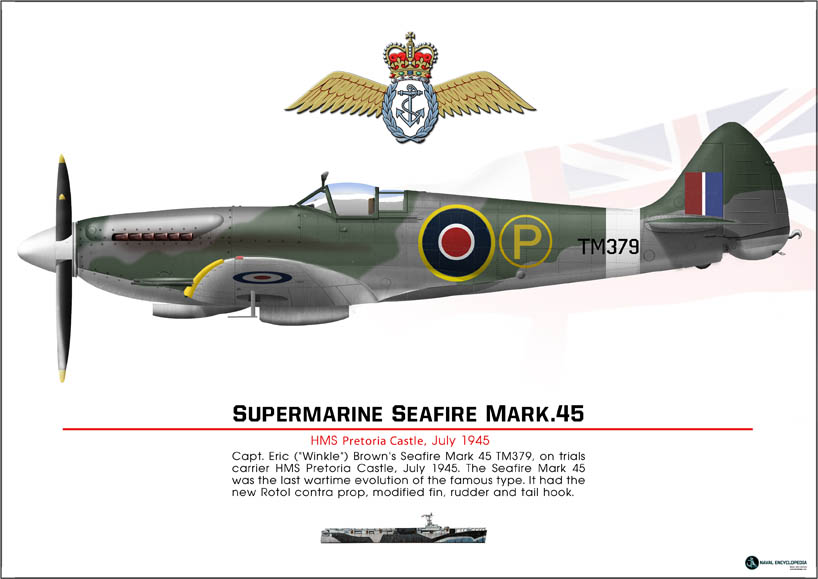
Seafire Mark 45; HMS Pretoria Castle
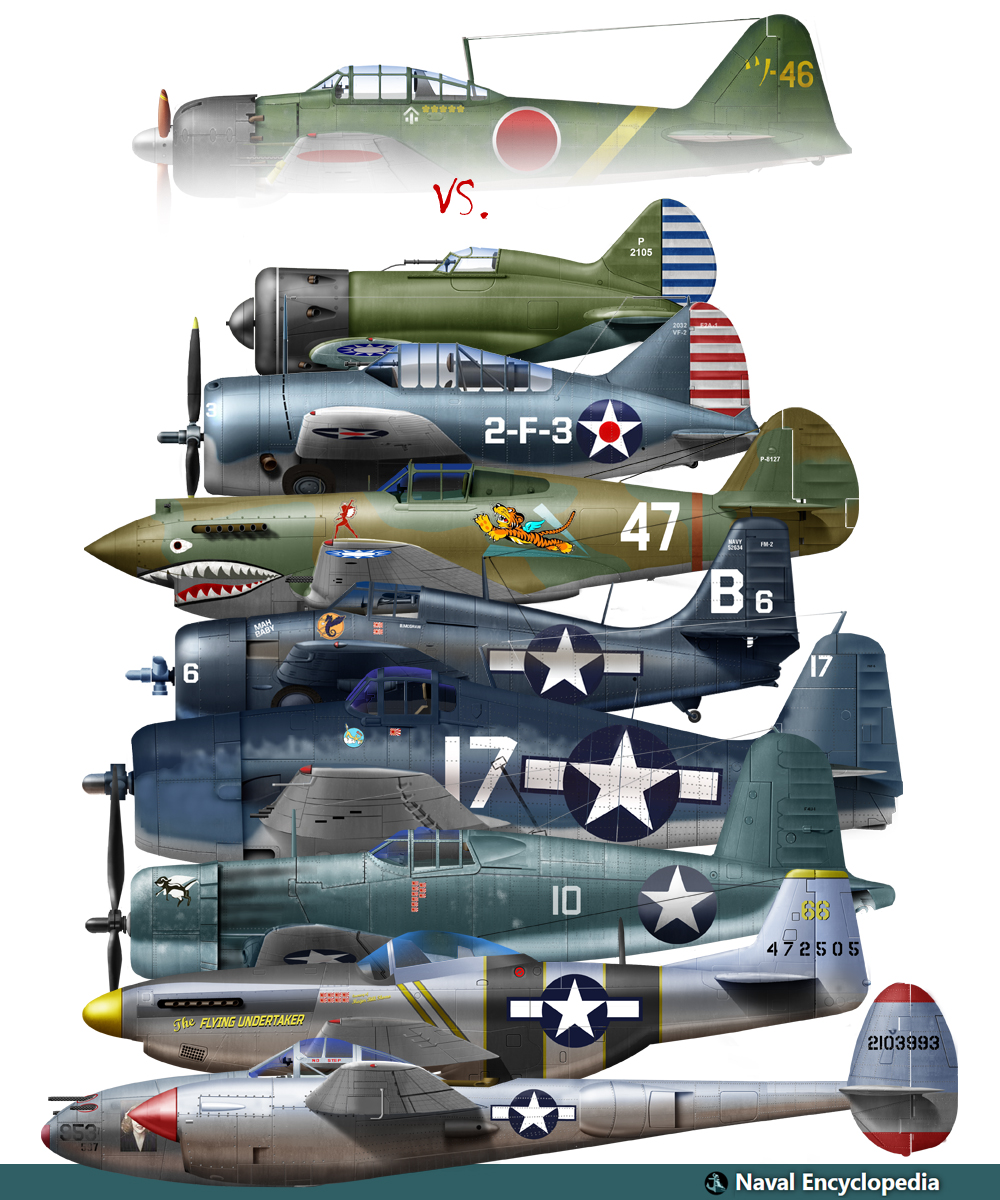
Zeros vs its aversaries
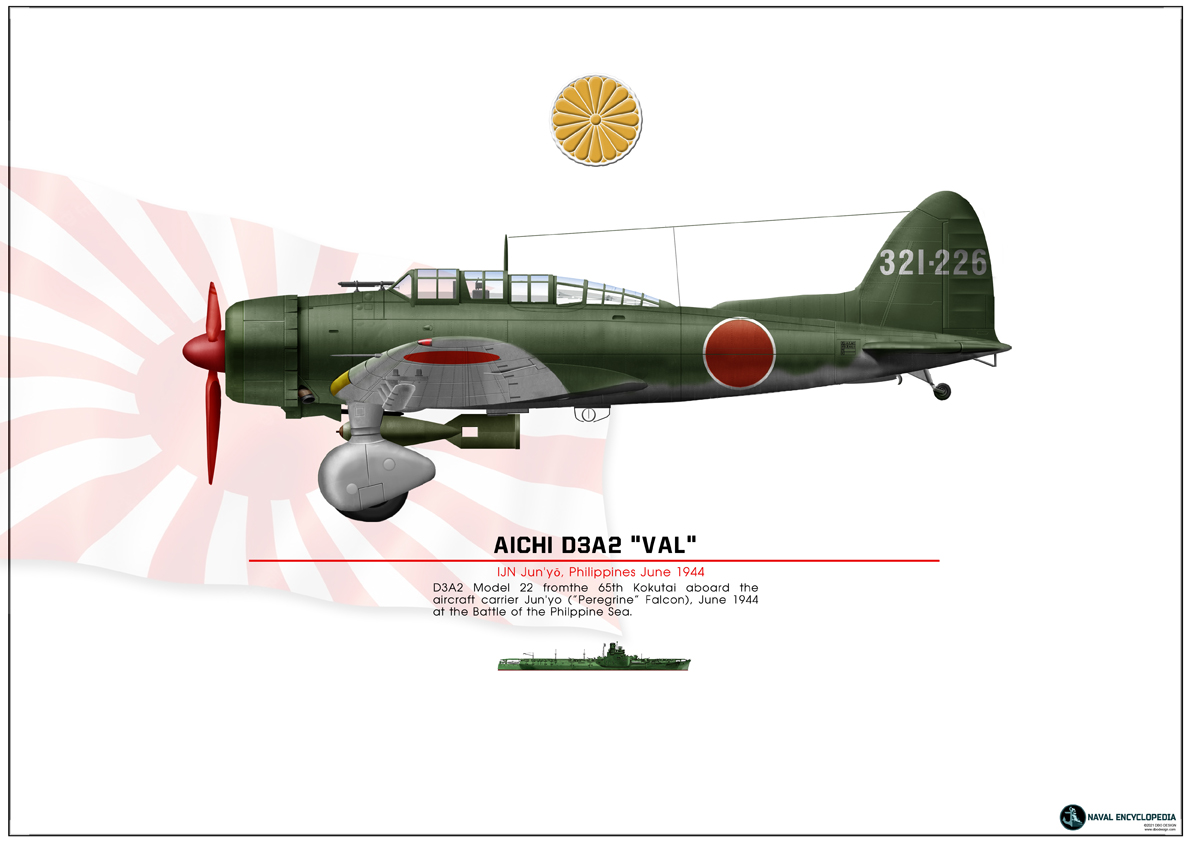
Aichi D3A “Val” Junyo
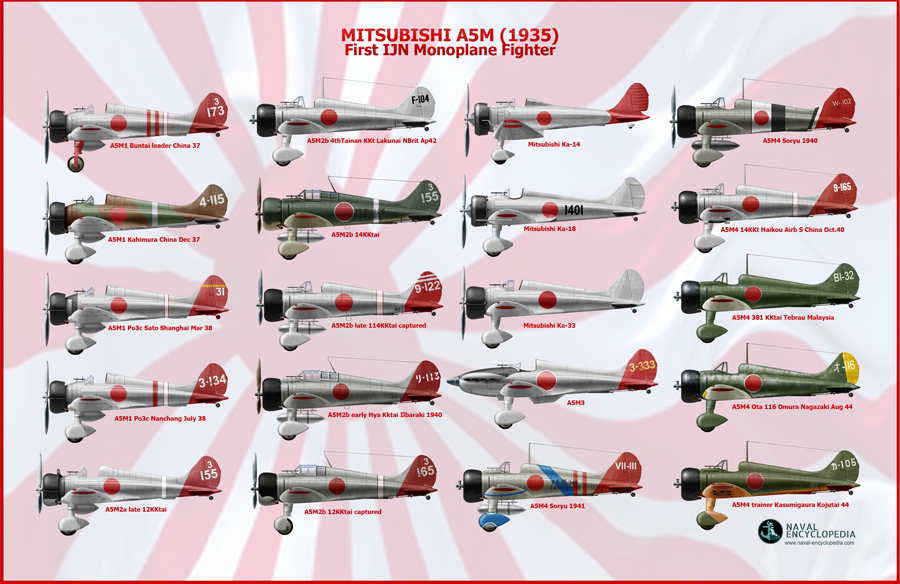
Mitsubishi A5M poster
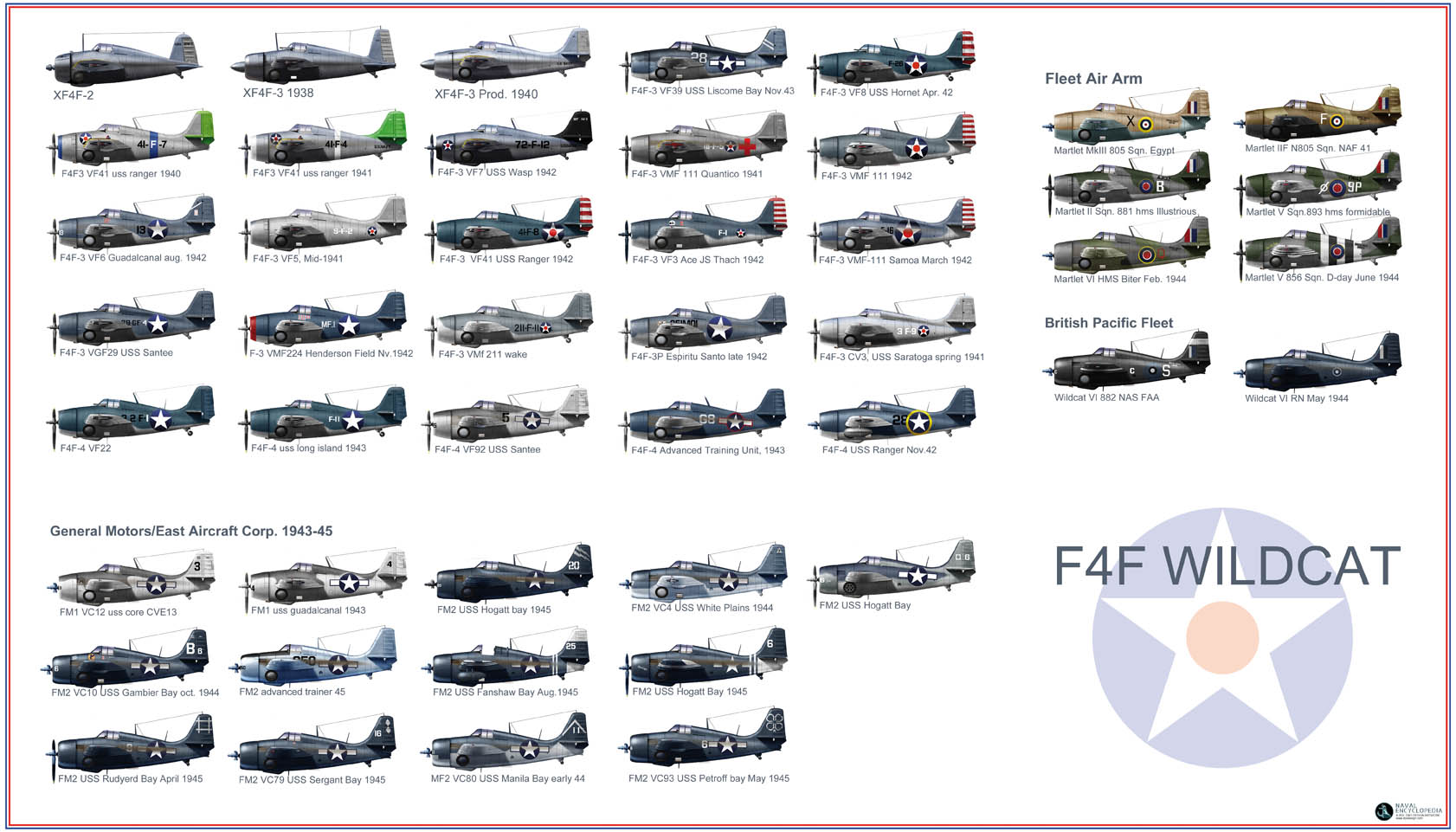
F4F wildcat
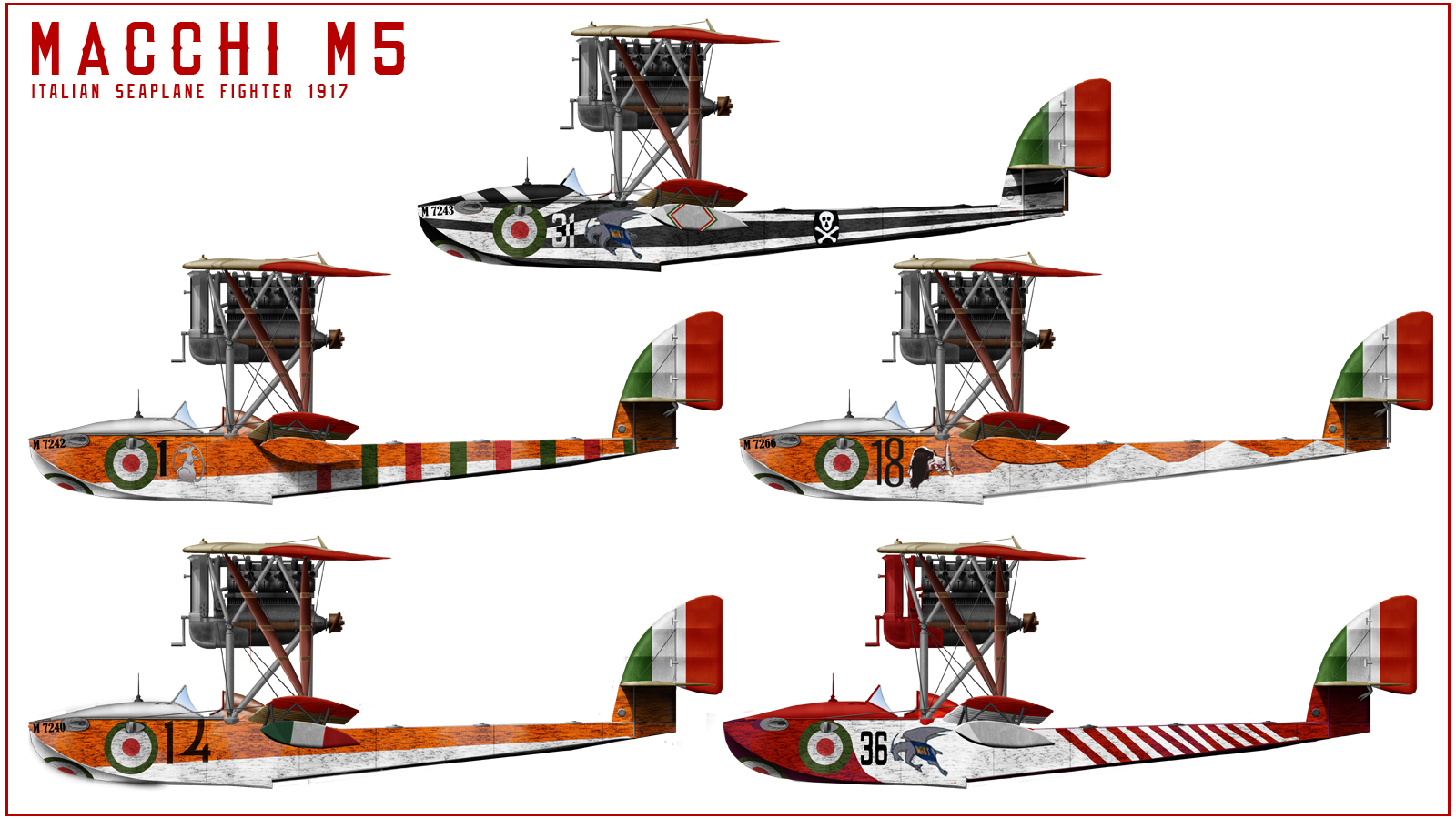
Macchi M5
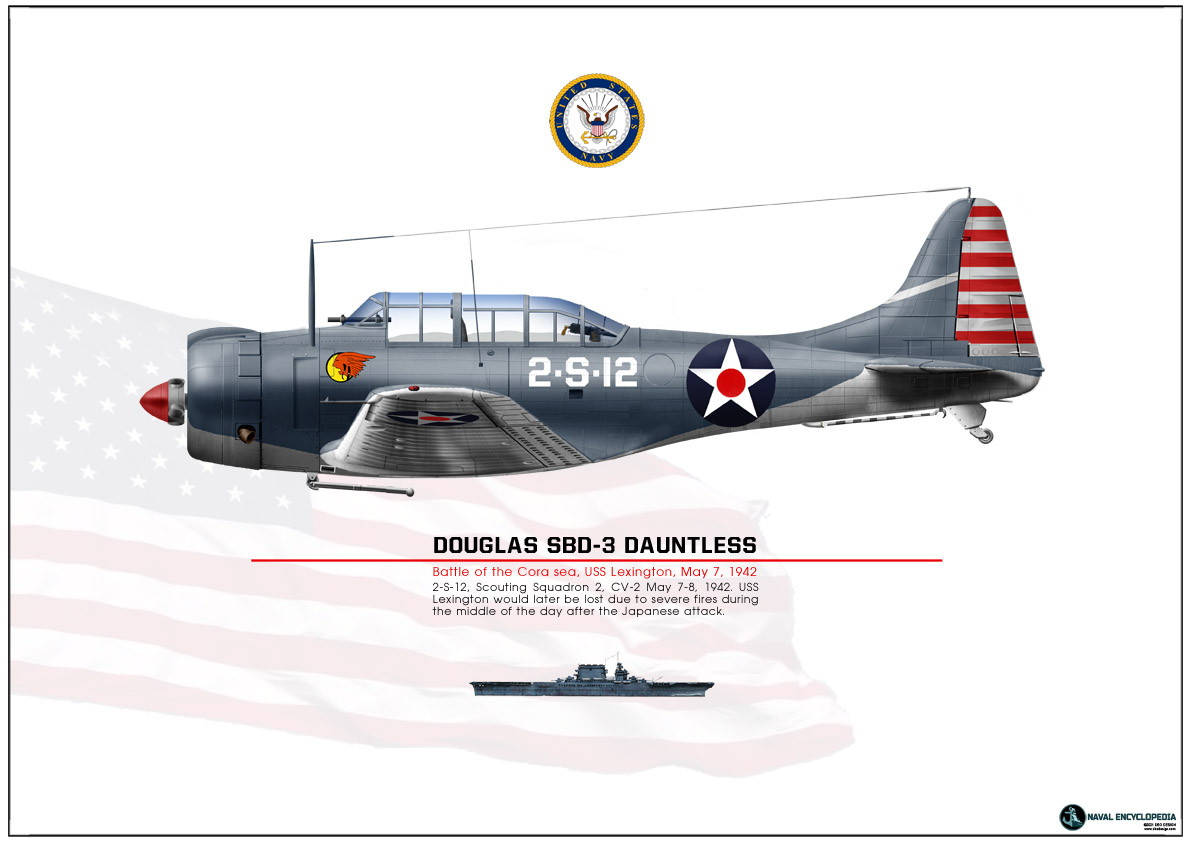
SBD Dauntless Coral Sea
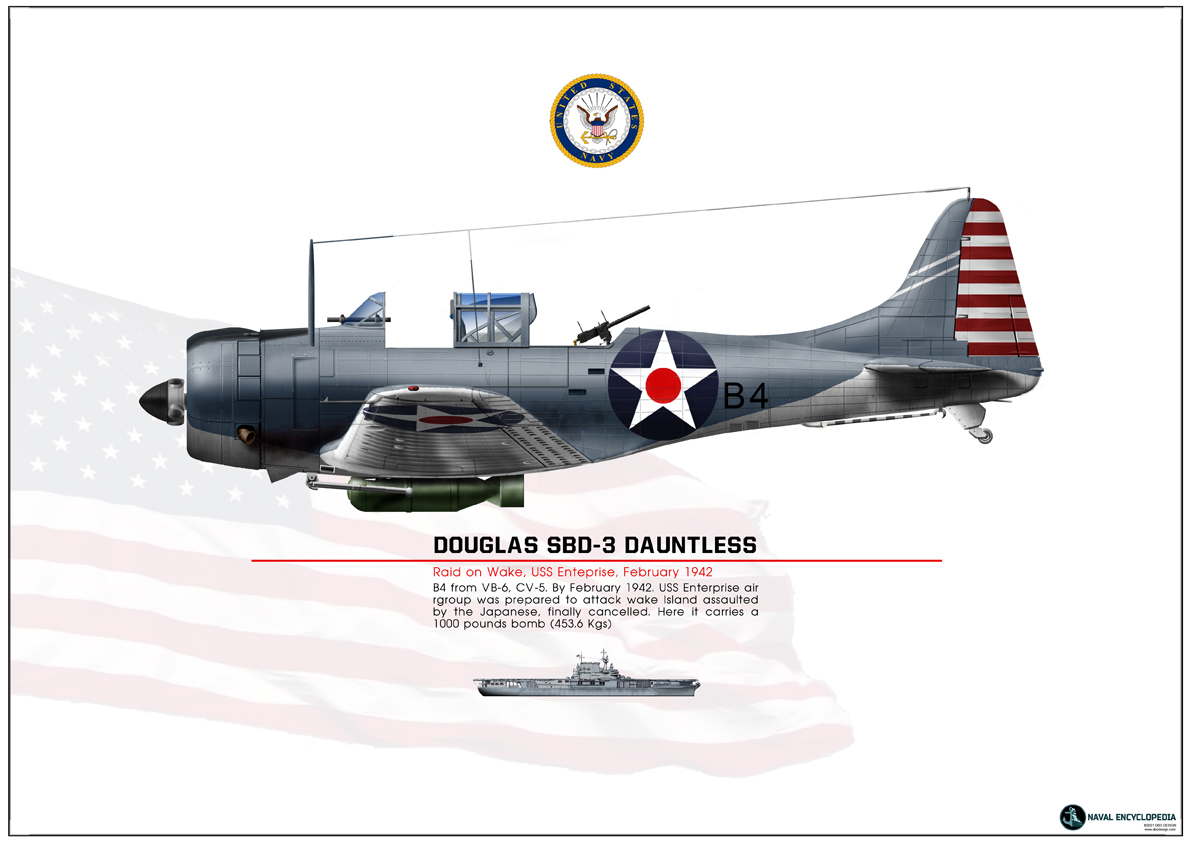
SBD Dauntless USS Enterprise
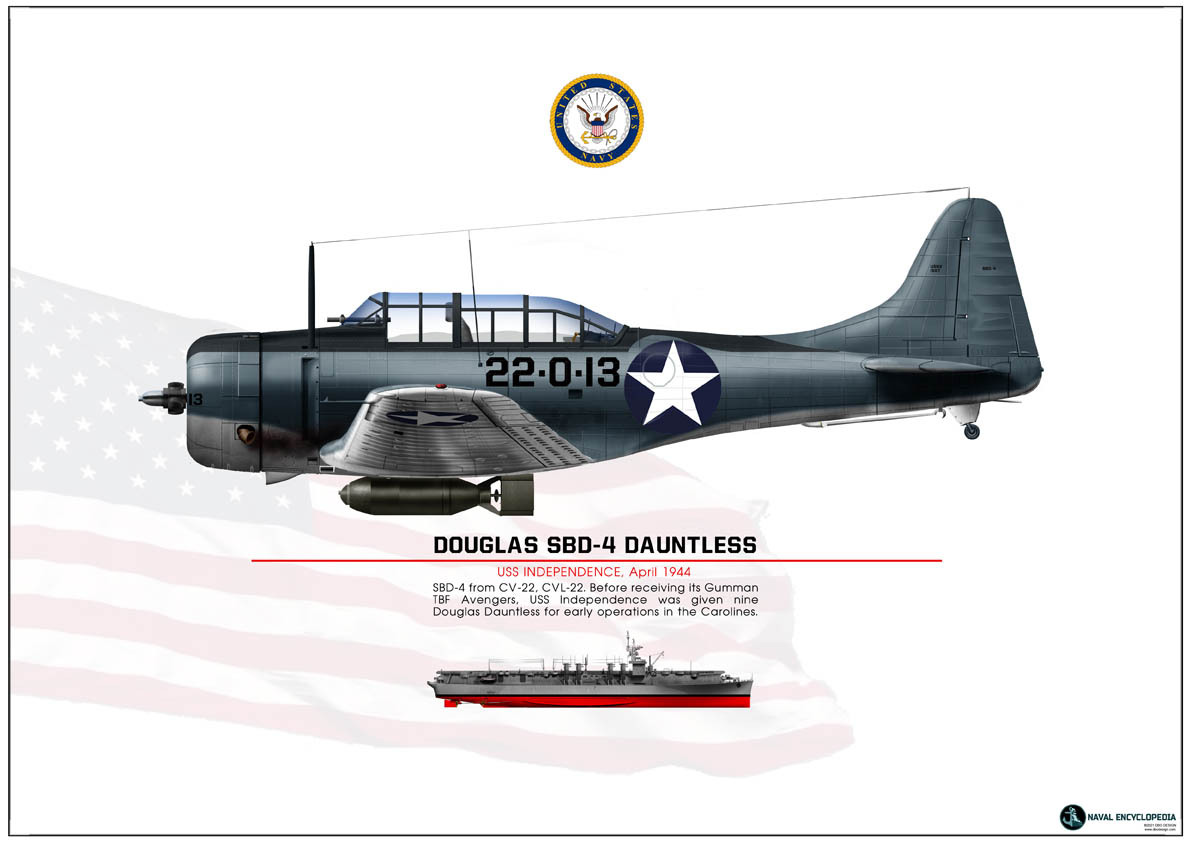
SBD-4 CV22